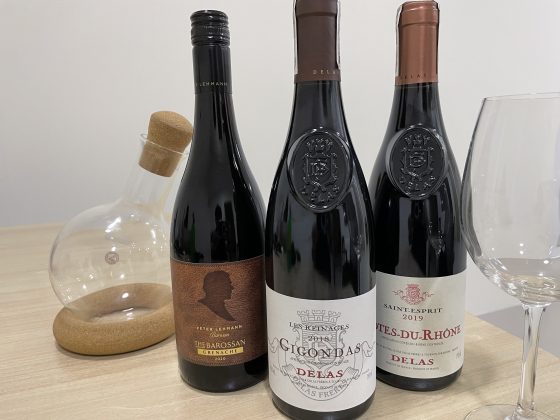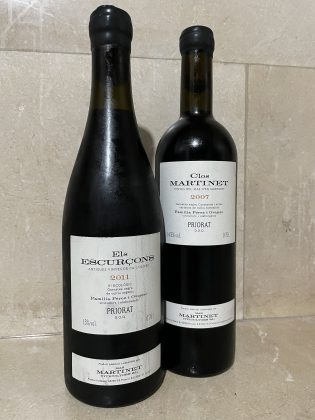Appreciating the Grenache varietal wine
OUTSIDE of Nebbiolo, Tempranillo and Cabernet Sauvignon, my next favorite red varietal is probably Grenache, or Garnacha as it is known in Spain.
Not really known as a mono-varietal wine, even though 100% Grenache can be found in parts of Spain, France, and in the New World countries of Australia and the US, primarily California.
In Spain, a good selection of 100% Garnacha wines can be found in: 1.) the Southern Aregon wine regions of Carinena and Campo de Borja — Bodegas Barsao’s Tres Picos from this DO is quite good; 2.) Priorat, the home of the oldest Grenache vines in the world — Cartoixa d’Scala Dei from this region is absolutely delectable; and, 3.) Rioja, even if Tempranillo is still the undisputed star of this DOCa region — Conde de Valdemar Garnacha is a great example.
In Australia, Grenache is grown mostly in South Australia, where it headlines the GSM or Grenache-Shiraz-Mataro (Mataro is Mourvedre in France) blend, with Barossa Valley churning out really good, aromatic, fuller bodied 100% Grenache versions. The Yalumba Barossa Bush Vine Grenache found in Ralph Wine Shop is an easy wine to love. I like Grenache, even if it does not have that aesthetically appealing deep dark red to purple wine hue we find in Cabernet Sauvignon, Syrah, Malbec, or Zinfandel.
Grenache just appeals to me because it can make real complex wines with its unique floral and violets aromas, red fruits from raspberries to strawberries, gamey and earthy notes, not overly acidic nor tannic. This varietal also improves with oak aging and has that extra alcohol kick too ranging in the 15% strength when fermented dry.
FRENCH GRENACHE
Southern Rhone is the French wine region most known for Grenache wines. Some top-of-mind AOC regions from Southern Rhone include Chateauneuf-du-Pape, Gigondas and Cotes du Rhone. In these three regions, it is hard to find, though it is possible, 100% Grenache wines mainly because of respective AOC rules on blending varietals. But Gigondas would probably come closest to 100% Grenache as most producers are using up to 80% of Grenache in their blend which includes prominent Rhone staples Syrah and Mourvedre. Chateauneuf-du-Pape also uses majority of Grenache in their blend, probably in the 70-75% range, and aside from Syrah and Mourvedre, there are 10 other authorized varietals used in a Chateauneuf-du-Pape rouge wine blend.
Other Southern Rhone AOCs known for using Grenache includes Cotes du Rhone, Vacqueyras, Ventoux (formerly known as Cotes du Ventoux), and the Rosé-only Tavel.
THE GARNACHA FROM PRIORAT
Priorat is one of only two DOCs or Denominación de Origen Calificada in Spain (though it is labeled in Catalan as Denominació d’Origen Qualificada) — the highest classification for a wine region. This is roughly equivalent to Italy’s DOCG or Denominazione di Origine Controllata e Garantita. Priorat got promoted to DOCa from DO Denominació d’Origen in 2001, while the only other DOCa is none other than Spain’s most renowned wine region of Rioja, which got the first DOCa classification in 1991.
What is remarkable is Priorat has only around 2,000 hectares of vineyards and has also one of the lowest yields per hectare in wine production. This has a lot to do with the less productive older vines, very warm climate with little rainfall, and the terrain of the vineyards which are found in steep slopes requiring labor-intensive hand harvesting. But Priorat does have the advantage of a unique soil known as Llicorella — a red soil that is made of black slate with particles of mica and seems perfect for this unforgiving hot climate as Llicorella can absorb heat and is good at retaining water for the long-haul. Llicorella also has inherent minerality that shows up nicely in Priorat wines.
Garnacha vines are the best fines in this region, with the first five pioneers of the Priorat movement in the late 1980s all believing in the potential of the Garnacha varietal. For three years, from 1989 to 1991, this group of five winemakers collaborated to pool the grapes from their respective vineyards, their resources, winemaking skills and shared a winery in Gratallops to make one common wine (though sold under their respective labels). This collaboration triggered the quality evolution in Priorat.
These five pioneering winemakers are still very much visible now with their respective wineries. The most famous, and with the most expensive showcase Priorat wine, the L’Ermita (easily over $1,000/bottle) is Alvaro Palacios under his eponymous winery name. Other Priorat movement members include René Barbier, the leader of the pack, under his Clos Mogador winery; Daphne Glorian of Clos Erasmus; Charles Pastrana of Clos de l’Obac; and Josep Luís Pérez of Mas Martinet. All these five wineries still represent some of the best, if not the best wines in Priorat, which now has over 100 wineries and a growing international reputation for its amazing red wines.
Quantities of their wines are not huge, and they are not cheap too, so some effort may be needed to track these wines down, but they are absolutely worth the money and effort.
Garnacha is still Priorat’s most important varietal and is around 40% of total vineyard plantings in the region.
PRIORAT WINES VS OTHER REGIONS’ GRENACHE WINES
Personally, I feel that the Priorat’s Grenache-dominant wines are really at a different level vis-a-vis their counterparts, including those from Chateauneuf-du-Pape, from Barossa and even from California. Sadly, I never had the chance to taste California’s most acclaimed Grenache wine, Sine Qua Non. I, however, have tasted a few also highly touted Grenache wines, like the Bonny Doon La Cigare Volant. La Cigare Volant is Bonny Doon’s Southern Rhone blend which still contains majority Grenache, and I thoroughly enjoyed this wine, which is a great taste bud changer from our usual fixation with Californian Cabernet Sauvignons, in particular those from Napa Valley.
The author is the only Filipino member of the UK-based Circle of Wine Writers (CWW). For comments, inquiries, wine event coverage, wine consultancy and other wine related concerns, e-mail the author at wineprotege@gmail.com, or check his wine training website https://thewinetrainingcamp.wordpress.com/services
While I have very small sample size of tasting Californian Grenache, I had a more sizeable experience tasting Grenache or Garnacha from Priorat, Barossa, and Rhone. Priorat Garnacha somehow just has a different feel to it. For one, there is a minerality that is more pronounced, which I enjoyed so much, when pleasantly integrated with the luscious fruits, tart, and viscosity of the wine. The Rhone Grenache wines have more floral notes and are a bit more feminine compared to their Spanish counterparts. The Barossa Grenache wines, on the other hand, are more straight-forward, somehow simpler, and have a candied ripeness.
Very recently, I had two very nice Priorat wines back-to-back: the Clos Martinet 2007 and Els Escurcons 2011 — both from one of the five pioneers, Mas Martinet. Both these wines were amazing, and despite being 14- and 10-years-old respectively, both wines were still vivacious and vibrant, full bodied. But the Els Escurcons, which I know to be 100% Garnacha, had more tar characteristics with tobacco leaves, raisins, and longer, lingering finish at the end.
My normal go-to Priorat wine is Mas d’en Gil, which I imported into the country for many years already, but sadly had to discontinue because top Priorat wines are just too expensive and are not saleable to the Filipino wine buyers. Mas d’en Gil has two incredible wines: the Coma Vella and the Clos Fonta. If you see them available in your travels, you will not regret buying them.
If you are not familiar with Grenache, it is time to take a closer look at this varietal. Search for Grenache and its wine regions in your favorite wine store or online wine shop, and let me know your thoughts on these wines when you taste them.
The author is the only Filipino member of the UK-based Circle of Wine Writers (CWW). For comments, inquiries, wine event coverage, wine consultancy and other wine related concerns, e-mail the author at wineprotege@gmail.com, or check his wine training website https://thewinetrainingcamp.wordpress.com/services





